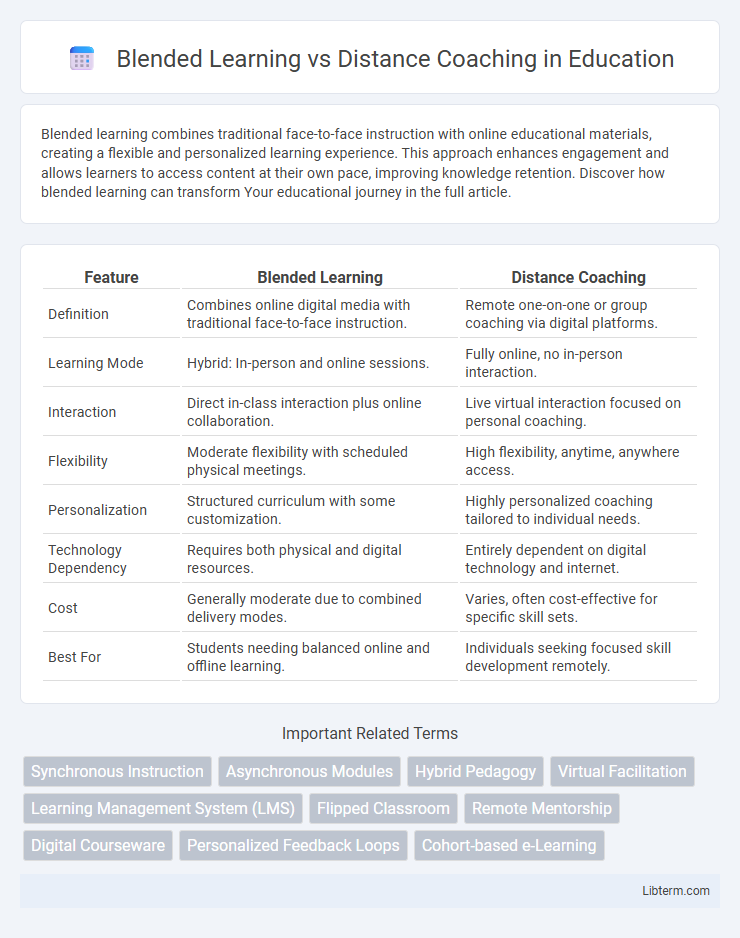Blended learning combines traditional face-to-face instruction with online educational materials, creating a flexible and personalized learning experience. This approach enhances engagement and allows learners to access content at their own pace, improving knowledge retention. Discover how blended learning can transform Your educational journey in the full article.
Table of Comparison
| Feature | Blended Learning | Distance Coaching |
|---|---|---|
| Definition | Combines online digital media with traditional face-to-face instruction. | Remote one-on-one or group coaching via digital platforms. |
| Learning Mode | Hybrid: In-person and online sessions. | Fully online, no in-person interaction. |
| Interaction | Direct in-class interaction plus online collaboration. | Live virtual interaction focused on personal coaching. |
| Flexibility | Moderate flexibility with scheduled physical meetings. | High flexibility, anytime, anywhere access. |
| Personalization | Structured curriculum with some customization. | Highly personalized coaching tailored to individual needs. |
| Technology Dependency | Requires both physical and digital resources. | Entirely dependent on digital technology and internet. |
| Cost | Generally moderate due to combined delivery modes. | Varies, often cost-effective for specific skill sets. |
| Best For | Students needing balanced online and offline learning. | Individuals seeking focused skill development remotely. |
Introduction to Blended Learning and Distance Coaching
Blended learning combines traditional face-to-face instruction with online educational materials, creating a hybrid model that offers flexibility and personalized learning experiences. Distance coaching delivers skill development and mentorship entirely through digital platforms, enabling learners to access expertise regardless of geographic location. Both methods leverage technology to enhance educational accessibility and engagement, but blended learning integrates in-person interaction while distance coaching relies exclusively on remote communication.
Key Differences Between Blended Learning and Distance Coaching
Blended learning combines traditional face-to-face instruction with online educational content, allowing interactive, real-time engagement and hands-on practice, whereas distance coaching relies entirely on remote digital platforms without in-person interaction. Blended learning often uses a hybrid model that supports diverse learning styles through synchronized and asynchronous activities, while distance coaching emphasizes personalized guidance primarily through virtual communication tools like video calls and messaging. The key differences lie in the mode of delivery, interaction intensity, and the balance between self-paced and instructor-led components.
Advantages of Blended Learning
Blended learning combines online digital media with traditional classroom methods, enhancing student engagement and improving retention through interactive and personalized instruction. It offers flexibility in schedule while providing face-to-face interaction, which fosters immediate feedback and deeper understanding. This hybrid approach supports diverse learning styles, promotes collaboration, and often leads to higher academic achievement compared to distance coaching alone.
Benefits of Distance Coaching
Distance coaching offers unparalleled flexibility, enabling learners to access expert guidance from any location without the constraints of travel or fixed schedules. It enhances personalized learning by leveraging digital tools for real-time feedback and tailored content, promoting higher engagement and retention. Cost-effectiveness is another key benefit, reducing expenses related to physical venues and materials while maintaining high-quality instructional support.
Challenges Faced in Blended Learning
Blended learning faces challenges such as technological disparities, where students may lack reliable internet access or suitable devices, hindering participation. The complexity of integrating online and face-to-face instruction can strain educators who need to design cohesive lesson plans and manage diverse learning environments. Furthermore, maintaining student engagement and motivation proves difficult when learners must switch between virtual and physical classrooms.
Common Obstacles in Distance Coaching
Common obstacles in distance coaching include limited real-time interaction, technology barriers, and reduced learner engagement compared to blended learning, which integrates face-to-face sessions for immediate feedback and social presence. Technical issues such as unstable internet connections and platform usability can hinder effective communication and content delivery in distance coaching. Motivating learners remotely and ensuring consistent progress tracking remain significant challenges without the blended learning model's combination of online and in-person support.
Ideal Scenarios for Implementing Blended Learning
Blended learning is ideal in scenarios where learners benefit from both in-person interaction and online flexibility, such as corporate training environments requiring hands-on practice alongside theoretical knowledge. It suits educational settings with diverse learner needs, combining face-to-face support with digital resources to enhance engagement and retention. Implementation thrives in institutions aiming to maximize resource use while maintaining personalized instruction through integrated technology platforms.
When to Choose Distance Coaching Over Other Methods
Distance coaching is ideal when learners require flexible schedules, personalized support, and access to expert guidance regardless of location. This method suits professionals balancing work commitments or students in remote areas lacking reliable transportation. Choosing distance coaching maximizes convenience and individualized learning in scenarios where blended or traditional in-person methods are impractical.
Future Trends in Education: Blended Learning and Distance Coaching
Future trends in education emphasize the integration of blended learning and distance coaching to enhance personalized student engagement and flexibility. Advances in AI-driven platforms and virtual reality are increasingly enabling immersive blended environments, while distance coaching leverages real-time analytics and adaptive feedback to support remote learners effectively. The convergence of these modalities is expected to create hybrid educational models that optimize accessibility, skill mastery, and lifelong learning opportunities.
Conclusion: Choosing the Right Approach for Your Needs
Blended learning combines face-to-face interaction with online resources, offering flexibility and personalized support ideal for learners seeking a balanced approach. Distance coaching relies entirely on virtual communication, providing accessibility and convenience for those with tight schedules or remote locations. Selecting the right approach depends on your learning style, goals, and availability to ensure optimal engagement and success.
Blended Learning Infographic

 libterm.com
libterm.com